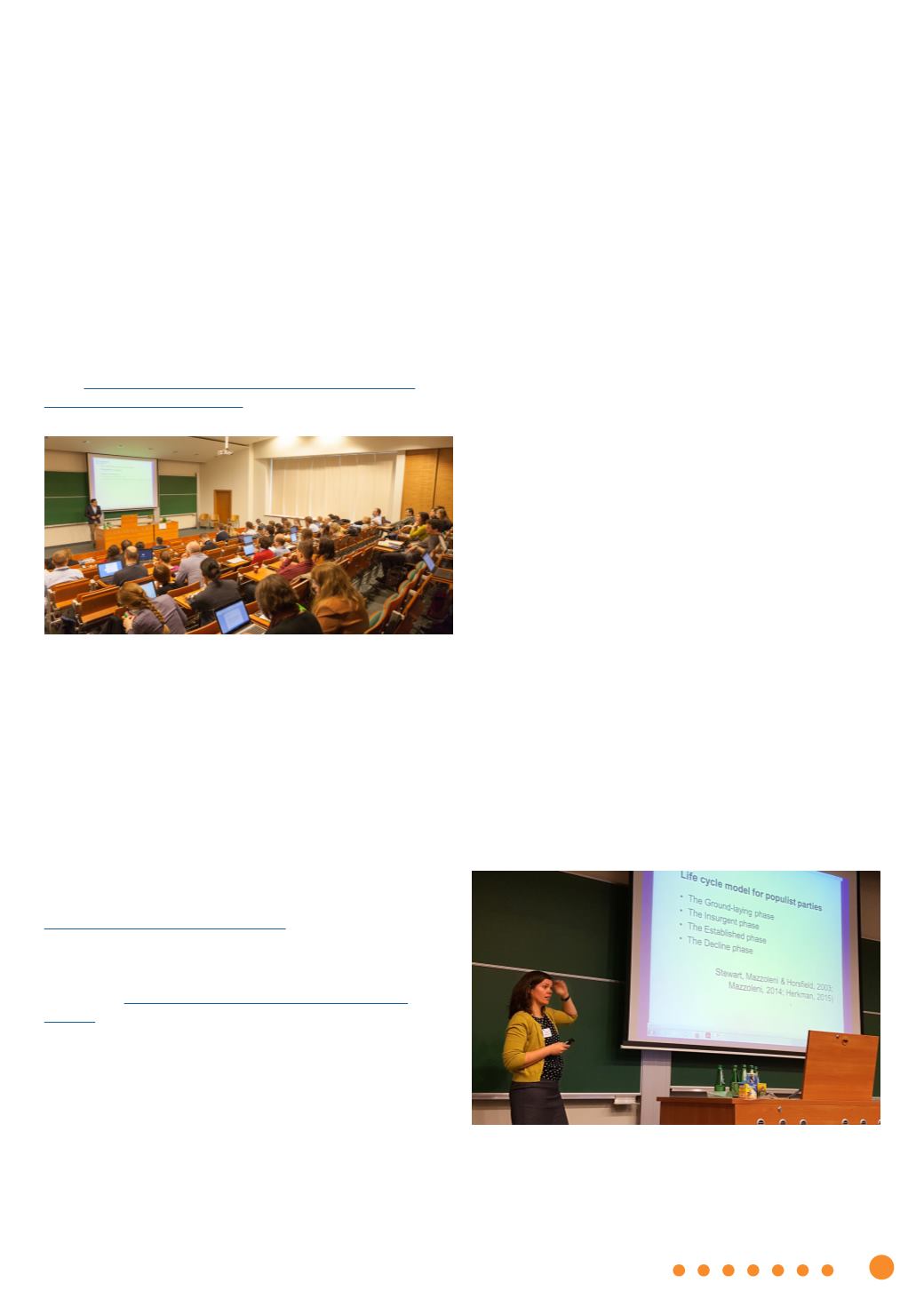

Newsletter
•
No. 2, July 2016
3
Paper presentation by Bente Kalsnes
both in small and large N studies, and the fundamental
choice between most similar and most different systems
designs. Another key issue in conducting comparative
empirical research is to ensure equivalence, i.e., the ability
to validly collect data that are indeed comparable between
different contexts and to avoid biases in measurement,
instruments and sampling. Frank went on to introduce a
typology of different types of research questions that can
be addressed with comparative research, as well as the
most common statistical techniques associated with those
research questions. Finally, he discussed how trends such
as globalization alter our understanding and practice of
conducting comparative research. The talk concluded with
suggestions as to how comparative designs need to expand
to account for these trends. The manuscript can be found
here:
http://www.nccr.democracy.uzh.ch/publications/workingpaper/pdf/wp_86.pdf
Audience at workshop
Comparative survey research
In his plenary lecture, Claes de Vreese gave an overview
of developments in public opinion and survey research. He
used the example of attitudes of citizens towards the EU
to illustrate comparative survey based research. He also
provided an overview of key challenges of comparative
survey research, across contexts, time, and modes of data
collection. He finally addressed the specific challenge for
political communication research on tapping exposure to
political information in a changing information environment.
Two resources are available to students and scholar: the
http://mediaexposuremeasures.orgwebsite is a free and
interactive platform to consult existing ways of tapping
exposure and a new special issue of Communication
Methods and Measures addresses this challenge
specifically:
http://www.tandfonline.com/toc/hcms20/current
Paper presentations
The afternoon of the workshop was spent discussing
ongoing research. In the first round of paper presentations
Ioannis Andreadis presented a paper, written together
with Yannis Stavrakakis and Giorgos Katsambekis, on
how academics may use surveys to measure the populist
attitudes of political elites. To illustrate this, the authors
included findings from a Greek pilot study. The next two
papers in this session presented to two case studies.
Cristina Cremonesi discussed the controversial case of the
Five Star Movement, and whether it can be placed to the
left, to the right or if it does not have any ideology, while
Peter Csigó presented a paper titled “The suicidal populism
of Viktor Orbán in 2002”.
The second round of paper presentations started with a
presentation by Giuliano Bobba on “Social media populism.
The rise of populism in Italy and the role of social media”.
Looking at the presence of four pillars – the people, elites,
democracy, and others – his study showed that Italy only
discerns soft and hard populist parties, no non populist
ones, or potential populists. Bente Kalsnes also looked at
social media, but focused on use of social media instead
of content produced on social media. In her paper, “The
power of viral shares: Strategic use of social media in
two populist political parties”, she shows that both the
Norwegian Progress Party (PP) and the Sweden Democrats
(SD) have a realistic social media strategy. However,
whereas the PP interact with voters, the SD uses social
media to get normalized. Ov Cristian Norocel presented the
study he conducted with Gabriella Szabó on “Mapping the
populist radical right media in public spheres: the case of
Hungary and Romania”. Their study shows that in Hungary
the radical right media are peripheral to the mainstream
media network, and the debate is polarised along
ideological lines. In Romania, however, the radical right
media are completely outside of the mainstream media
network, and also part of different frame networks. Finally,
Michael Hameleers presented the study he conducted with
Linda Bos and Claes de Vreese called “On media populism:
Exploring the link between media preferences and citizens’
populist attitudes”. In the study they showed that populist
attitudes of citizens are in sync with their populist media
preferences. Voters with anti-establishment attitudes
prefer media content in which the people are central, and
there is less attention for elites and experts. Voters with
exclusionist attitudes also prefer media content in which
the people are central, as well as monocultural media.
The third round of paper presentations started with a
presentation by Nayla Fawzi on “The media lie! Are populist
citizens more sceptical towards the media than their fellow
citizens ?” Looking at German citizens attitude, her study
















